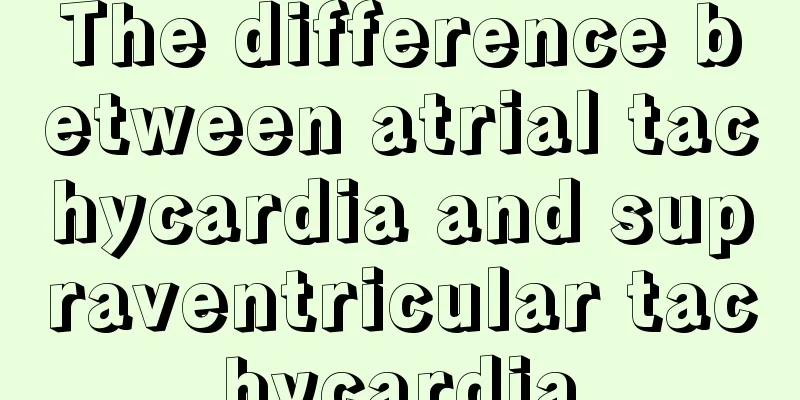The difference between atrial tachycardia and supraventricular tachycardia

|
What is the difference between atrial tachycardia and supraventricular tachycardia? This is a question many people want to ask. Ventricular tachycardia is a manifestation of heart disease and is the abbreviation of supraventricular tachycardia. Patients experience palpitations and discomfort in the precordial area, and an electrocardiogram shows a heart rate of more than 100 beats per minute. This disease is relatively common in clinical practice and can easily cause sudden death. The prevention of this disease is also very important. Patients should pay attention to rest and avoid overwork. Atrial tachycardia is abbreviated as AT. The pacemaker that causes tachycardia is located in the atrium. Supraventricular tachycardia is abbreviated as SVT. It mainly includes paroxysmal supraventricular tachycardia, autonomous atrial tachycardia and non-paroxysmal junctional tachycardia. Paroxysmal supraventricular tachycardia is a paroxysmal rapid and regular ectopic rhythm. The difference between it and atrial tachycardia is that the origin of the problem is different! Atrial tachycardia (AT), also known as AT, is a rapid atrial arrhythmia caused by atrial ectopic excitation. When the disease occurs, patients usually experience palpitations, which are mostly short or paroxysmal. The diagnosis is confirmed by an electrocardiogram when the disease occurs. According to the different mechanisms and electrocardiographic manifestations, atrial tachycardia can be divided into autonomous atrial tachycardia, reentrant atrial tachycardia and disordered atrial tachycardia. With the widespread application of catheter ablation technology for arrhythmias, in order to facilitate mapping and ablation, atrial tachycardia is currently more often classified into two types: focal atrial tachycardia and macro-reentrant atrial tachycardia. The electrocardiographic manifestations of atrial tachycardia are as follows: ① the atrial rate is usually 150 to 200 beats per minute; ② the P wave morphology is different from that of sinus tachycardia, and varies according to the location of the atrial ectopic focus or the mechanism of atrial tachycardia; ③ Second degree type I or type II atrioventricular block often occurs, and 2:1 atrioventricular conduction is also common; ④ The isoelectric lines between the P waves still exist (different from the disappearance of isoelectric lines in typical atrial flutter); ⑤ Stimulation of the vagus nerve cannot stop tachycardia, but only aggravates atrioventricular block; ⑥ The heart rate gradually accelerates at the beginning of the attack. Electrophysiological examination characteristics ① In patients with abnormal automatic mechanism, programmed atrial stimulation usually cannot induce or terminate tachycardia, and the attack is not dependent on intra-atrial or atrioventricular node conduction delay; ②The P wave is different from the sinus P wave; ③There is a "warm awakening" phenomenon when tachycardia occurs; ④It can be temporarily suppressed by overspeed, but it cannot terminate the tachycardia attack; ⑤ The first P wave of tachycardia has the same morphology as the subsequent P waves. Supraventricular tachycardia is abbreviated as SVT. It mainly includes paroxysmal supraventricular tachycardia, autonomous atrial tachycardia and non-paroxysmal junctional tachycardia. Paroxysmal supraventricular tachycardia is a paroxysmal rapid and regular ectopic rhythm. It is characterized by sudden onset and sudden cessation. During an attack, the patient feels his heart beating very fast, as if it is about to jump out, which is very uncomfortable. During an attack, the heart rate is 150 to 250 beats per minute and lasts for seconds, minutes, hours or days. Sometimes when the doctor arrives, the patient's attack has already ended. Palpitation may be the only symptom, but if there is a history of coronary heart disease or other heart disease, dizziness, fatigue, difficulty breathing, angina pectoris, syncope, and electrocardiogram changes showing myocardial ischemia may occur. In most cases, the presence of an atrioventricular accessory tract or differences in the conductivity and refractory nature of the atrioventricular node function is the basis for its occurrence. |
<<: Effects of Amisulpride on the Brain
>>: There is a dull pain in the lower right side of the ribs
Recommend
What to do if you have a bad heart and can't sleep
A bad heart affects people in many ways, especial...
How to massage breasts to make them bigger, you need to know these two acupoints
With the trend of society, many women want to hav...
What is a swollen inguinal lymph node?
Inguinal lymph node lumps are a common physical d...
What is the treatment time and method for kidney deficiency?
When facing the problem of kidney deficiency, pat...
Other common manifestations of ovarian cancer include compression symptoms
The more common manifestations of ovarian cancer ...
Can soaking your feet in pepper water remove moisture?
Soaking your feet in water with Sichuan peppercor...
What is the cause of tinnitus in the middle of the night
Sometimes when you are sleeping at night, you sud...
Early cure rate of testicular cancer
Testicular cancer is a disease that specifically ...
How to wash off oil stains on clothes
It is common for children to get oil stains on th...
What's causing the pain on the right side of my head?
The headache on the right side is what we call mi...
Taking baths less often can protect your skin better. Those "bad" habits that are good for your health
Everything has two sides. Even the bad habits tha...
Beware of these carcinogens in our body
There is also a mother in Australia whose son suf...
How to treat prostate cancer? Tell you 5 treatment methods for prostate cancer
Prostate cancer has been particularly prevalent i...
Is hamartoma harmful to the human body?
Hamartomas grow in many parts of the body, such a...
The main method of using chemotherapy to treat gastric cancer
Gastric cancer is a disease that is difficult to ...









